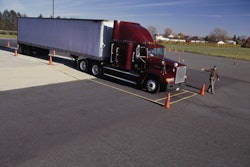A compliance review can be scary, but safety departments can prevail through careful and precise documentation and by being cooperative.
It may not be a trucking company’s biggest worry, but for the safety director, a compliance review probably ranks second only to a catastrophic accident. The stress is high, and the consequences are severe. Everyone in the company – especially the owners and officers – should be concerned. A carrier can face substantial civil penalties for violations of safety regulations or even for poor documentation of its compliance.
A rating other than satisfactory also can damage a carrier’s reputation and even disqualify it for business with some customers. And regulations the Federal Motor Carrier Safety Administration adopted a few years ago call for the agency to shut down a carrier that fails to improve upon an unsatisfactory rating within a reasonable period of time.
Surviving a compliance review requires thorough and ongoing attention to detail. Usually, it’s lack of proper documentation or adequate management controls – not willful disregard of the law – that trips up a carrier in a compliance review. Success or failure generally will be decided long before the auditor actually arrives.
Avoiding the audit
The best way to survive an audit is to never draw one. That’s not always within your control, but careful monitoring of your safety performance will help you respond promptly to problems that, left uncorrected, will make you a target of a compliance review down the road.
Although a driver complaint or dramatic, headline-grabbing crash, such as the major tanker accident on I-95 in January, can trigger a compliance review at any time, the principal
Compliance Reviews
by Carrier Size (Power Units)
1998-2002
reason a carrier draws an audit is its safety performance as measured by FMCSA’s Motor Carrier Safety Status Measurement System, or SafeStat. Using a complex set of formulas based on accidents, driver and vehicle inspection data, traffic citations and enforcement history, SafeStat ranks carriers based on presumed safety risk.
A carrier’s combined score from all the safety evaluation areas places it in an alphabetic grouping, with those deemed the highest risk ending up in Category A or B. A Category A or B carrier should assume that it could draw a compliance review at any moment.
SafeStat has been plagued by incomplete and untimely data, problems that are exacerbated by a methodology that is highly sensitive to such glitches. (For more on SafeStat’s problems, see page 20.) Even so, the trucking industry supports the idea of SafeStat as a big improvement over the more arbitrary process the feds used before the mid-1990s for targeting carriers. Today, the biggest concern probably is the public dissemination of SafeStat data through SafeStat Online (http://ai.volpe.dot.gov).
Much of what a carrier needs to know from SafeStat is available on the Web, but carriers can and should obtain their carrier safety profile regularly. The profile, which can be purchased in hard copy or electronic form, is available in a version that is provided only to the government and to the carrier itself. The detailed profile includes key information not publicly available – principally the names of drivers involved in inspections, accidents and traffic violations. The carrier safety profile is the auditor’s roadmap to a compliance review. By obtaining that roadmap, you can respond to trends and specific incidents before the auditor darkens your door.
Carlisle Carrier Corp. uses its carrier profile to target driver training and root out problems with maintenance. “You need to read and research it,” says Karol Kabroth, director of safety and claims administration for the Mechanicsburg, Pa.-based carrier. “If the brakes were out of adjustment, why did that happen?” But Kabroth doesn’t use the profile just for internal review and improvement.
Based on a match of the profile with Carlisle’s own records, Kabroth sometimes seeks to change an inspection report. “I’m not afraid to challenge a state,” she says. “Local police officers often conduct roadside inspections, and they may not be up on the latest criteria.” The challenge is to lower the out-of-service rate. “If you keep your out-of-service rate below 34 percent, you will keep the feds away,” Kabroth says.
Jet Express uses its carrier safety profile as a tool to conduct internal audits much the way a government auditor would. About a year ago, the Dayton, Ohio-based carrier began focusing the safety department’s resources squarely on drivers who showed up on its carrier profile as having had a safety event, says Jeff Davis, vice president of safety and human resources. “We are responsible for auditing 12,000 logs a month, so we had to focus our limited resources,” he says. “We found that we were spending so much time calculating the hours of service, we were falling short on the training aspect.”
The solution Davis devised was to conduct two levels of log auditing based on the carrier profile. All logs go through the basic audit, which checks for hours-of-service compliance, speed and other routine concerns. A random sample gets a more thorough audit. But there’s another group that gets a complete audit. If a driver shows up in a Jet Express carrier safety profile even once, that driver will receive training and automatically will be targeted for the complete audit for at least the next six months. And the carrier expects his logs to be perfect.
“We have focused the safety department resources on the area that will give you 80 percent of the problems during an audit,” Davis says. “I think what most carriers tend to do is a 50 percent job on all logs.” An auditor will target drivers with known violations, so it only makes sense for the carrier to do so as well, he says. An auditor will assume that a driver who has been caught for a violation once likely has committed that violation before and since, Davis points out. But carriers’ own auditing processes often aren’t based on that assumption.
Because carriers are targeted for audits based on SafeStat, savvy carriers can develop strategies aimed at keeping SafeStat scores low and greatly reduce the likelihood of an audit. The April issue of CCJ will address in detail ways in which carriers can influence their SafeStat scores.
Before the audit
Despite your best efforts, you may still find yourself at risk for a compliance review. While the safety director’s instinct might be to hunker down and hope the threat passes, the company probably will be better off with a more proactive approach.
“Once you have been notified of a compliance review or think you are on a trend toward one, brief everyone from corporate officers to office personnel to mechanics and drivers,” says David Saunders, vice president of Transplace Compliance Services. Saunders, who endured 13 compliance reviews as a carrier safety professional before joining Transplace, believes that carriers should communicate routinely with drivers and mechanics about SafeStat and its importance.
“If they can have hands-on driver and mechanics meetings, I strongly urge carriers to hand out copies of the carrier snapshot and the carrier profile,” Saunders says. “They then can understand that everyone equally shares in the responsibility.”
The most important step a carrier can take before an audit is to ensure that records are timely and that information is accurate, Saunders says. An auditor will not look favorably upon you if you haven’t kept documents, such as information in driver qualification files, up to date, he says. “The perception is you don’t have your house in order.” On the other hand, even if you have made mistakes, an obvious effort to maintain timely and accurate files goes a long way. “I have never had 100 percent recordkeeping, but I haven’t been fined because of my good-faith efforts,” Saunders says. He recommends that carriers maintain internal audit processes even if they outsource log auditing.
“The biggest thing is documentation,” says Keith Shartzer, director of safety for Louisville, Ky.-based Pegasus Transportation. “You often think it’s overkill. Overkill is best.” Tim Ingraham, safety manager for Pegasus, points out that safety personnel at his
Reason for compliance reviews 1998-2002
carrier staple to the inside of each driver qualification file a list of everything that must be in the file and the order they must be in. Two people must sign off on each item.
The drug and alcohol testing program is an area that carriers should pay extra attention to, Ingraham says. “They mean serious business on the random program. They question you about every particular situation on every single drug pull.”
How you manage your documentation prior to the audit is the key to survival, Shartzer says. “There’s nothing you can do once they are there.”
During the audit
The actual visit by the auditor is a tense time because you have conflicting priorities. You must show respect and cooperation, but you also want to exert as much control as possible.
“Greet the auditor and don’t make him wait,” Kabroth advises. Dedicate a comfortable, private space for the work, she says. And ensure that a single knowledgeable person is the auditor’s point of contact. “You don’t want him asking other people things.” During the audit, take notes and show you are interested in the auditor’s views and recommendations, Kabroth advises.
The auditor wields significant power and can ask for all manner of documents, but it’s a mistake to reinforce that behavior by giving him run of the operation, Davis suggests. “The carrier needs to take control from the start,” he says. Issue a name badge. Encourage the idea that for safety reasons they must be escorted at all times if they leave the auditing location. Also, to avoid confusion, the contact person for the company should set up any interviews that are requested by the auditor.
“I bend over backwards to accommodate them on information, but I say that I expect everything back in order and I’m only going to provide one set of documents at a time,” Davis says. That approach keeps the audit more organized and helps the carrier follow what the auditor has done. During the audit it is wise to copy everything the auditor reviews so that it can be checked for accuracy. It also helps to reaudit the logs the auditor is auditing to see if you reach the same conclusions, Davis says.
Perhaps the most important thing to remember is that the auditor is in your office to unearth problems and violations. Don’t be swayed by the usual “we’re here to help” attitude into helping the auditor more than you must.
An auditor might begin the process with an opening interview. The auditor probably will try to make that meeting as casual and friendly as possible – just as a police interrogator might do. “The interview is designed to build a scope of your operation, but actually that same information will be used against you,” Davis says. “Be cordial but offer little useful information.”
Similarly, an auditor might ask you to provide an affidavit to explain a particular situation or the absence of documentation. But you are under no obligation – at least in a compliance review – to sign an affidavit. And it is virtually impossible to correct a signed affidavit that was executed in error. “Do not sign any voluntary affidavits under any circumstances,” Davis advises. If the auditor is persistent, refer him to your counsel.
“Only give [auditors] the information they ask for,” Shartzer recommends. Pegasus was audited about three years ago, and Shartzer and his people followed the training they had received to be cooperative. “But we didn’t offer any additional information,” he says.
Carriers also should know what is required by law and regulation and what isn’t. You certainly don’t want to withhold documents, but that’s not a problem if you don’t have the document anymore. “We purge our files,” notes Ingraham. Logs, for example, are gone after 180 days. “We don’t offer any more than we are supposed to be offering.”
“Auditors may ask for information that you don’t have to supply,” Davis says. For example, an auditor may ask for an accident file. Most carriers place all information concerning an accident in one file. The added information – such as dispatch reports and insurance adjusters’ reports – may only lead to more questions. But under federal regulations, the only item required in an accident file is a state crash report if the state requires it.
But it’s a delicate balance, Davis concedes. “I can’t stress enough how important it is to not set up an adversarial situation. The more you get adversarial with them, the deeper they dig.”
After the audit
If you have done everything correctly, the audit will, theoretically, result in a satisfactory rating and no violations. If you aren’t so lucky, you will face some decisions. For example, if you receive a proposed conditional or unsatisfactory rating, you will have several weeks to respond by attempting to fix the identified problems.
You may also disagree with the auditor’s interpretations or conclusions and seek administrative review of the proposed rating. That’s a dicey path, however. If you want to upgrade a conditional rating as opposed to an unsatisfactory rating, your appeal may linger. Plus, if your appeal relies on questioning the auditor’s performance, you probably won’t win many friends in the state FMCSA office. The better path, Davis argues, usually will be to appeal a rating based on corrective action.
There are occasions when corrective action won’t matter, however. One of the six factors in a safety rating is the recordable accident rate, which can’t be corrected by a change in management systems. But a carrier can have an accident removed from calculation of the recordable accidents if it can show that an accident was not preventable. Preventability is considered, however, only when a carrier is above 1.5 recordable accidents per million miles. And you must submit, if available, a signed police report containing the investigating officer’s badge number and an insurance report signed by the investigator.
Your best survival strategy is to avoid a compliance review in the first place by limiting driver and vehicle out-of-service orders and preventing crashes. But still, audits happen. The key is to follow the rules to the letter. “You hear a lot of myths,” says Pegasus Transportation’s Shartzer. “If you go by the book, you aren’t going to have problems. If you go by what you hear from other carriers, you can run into problems.”
“The goal is to not be afraid of an audit,” Kabroth says. “That’s the level where every safety director wants to be. It’s a constant effort to stay there.”
Appendix B to Part 385 of the Federal Motor Carrier Safety Regulations explains the Federal Motor Carrier Safety Administration’s safety fitness procedures. You can find the appendix on the Web at this site.
For information on purchasing your carrier safety profile, visit this site.








